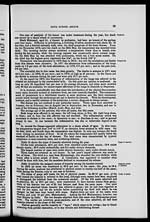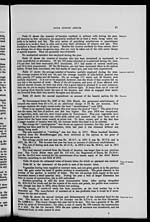Medicine - Mental health > 1867-1924 - Annual report of the insane asylums in Bengal > Insane asylums in Bengal annual reports 1867-1875 > Annual report on the insane asylums in Bengal for the year 1873
(718) Page 40
Download files
Individual page:
Thumbnail gallery: Grid view | List view

40 REPORT ON THE
In the list of physical causes, we find cholera, fever, debility, leprosy, and syphilis,
enumerated. These either cause poverty of blood or are manifestations of a system tainted
by some specific poison. In each vertigo is a common symptom. The ratio of treated
under these five heads is 7.5 per cent. of the total.
Epilepsy.
Epilepsy was assigned as a cause in 4 per cent. of the cases in 1872. This year
the proportion is only 2.6 per cent. During the year 10 males and six females were treated
for epileptic fits. Two died—one of paralysis of the insane, the other of phthisis pulmonalis.
In three individuals no fit occurred during the year, but the others had frequent attacks,
especially during the hot months.
Opium.
Insanity was ascribed to indulgence in opium in four cases, all males. Three were
Mahomedans of Eastern Bengal, and one a Hindu Keot from Assam.
Hereditary.
Hereditary predisposition was assigned as a cause in the cases of 10 males and three
females. In four cases the father was insane; in three, the mother; in one, the father's
brother; in one, the paternal grandfather; in one, the grandfather (which is not stated); in
one, the sister. In one, the father, mother, and uncle, were reported insane; and in one the
father, grand-mother, and grand-aunt. Eight were Mahomedans; five, Hindus.
It is remarkable that so few cases of insanity are referred to this cause. Although
lunacy is a bar to inheritance among Hindus, it is not among Mahomedans. Among neither
is it a bar to marriage, and a son of insane parents, whether he be himself insane or
not, finds no difficulty, beyond paying a larger dowry to the girl's parents, in procuring a
wife. Of late years it has become the custom for Hindus to make inquiries regarding the
existence of leprosy, insanity, and epilepsy in the family with which a marriage is
contemplated; but among Mahomedans, leprosy is the only disease objected to.
Moral causes.
To moral causes 19.60 per cent. of the total number of cases of insanity to which
a cause is assigned are referred.
Grief.
Grief, under which head are included—first, domestic troubles, secondly, the death
of some near relative, is, as was in former years, the most important moral cause. Ten
individuals had their madness referred to distress of mind; six, owing to loss of money in
trade; three, to unsuccessful litigation; and in one case to forgetfulness of a mantra. The
death of near relatives is said to have caused the insanity of four males and four females.
The fatalism of the Mahomedans does not preserve them from the effects of excessive grief,
for of the 18, 10 were Hindus, 8 Mahomedans.
Puerperal.
Insanity is referred to child-birth in three cases. The women were all subject to
melancholia with suicidal or homicidial tendencies.
Religion.
In one instance the terror excited by what was believed to be "bhut" ended in mania.
Religion is assigned as a cause in two instances. One, a Mahomedan chowkeedar had
been 20 years insane, and because his madness was characterized by great apparent devotion
and strict attention to the regulated number of prayers, this was imputed to be the cause of
his unsoundness of mind. The other was a Hindu who had become a convert to the " Guru
Sata," a modern outgrowth of Vishnuvism. The religious excitement he underwent proved
too much for his feeble mind, and he became mad.
Sickness.
Table 14 shows the annual return of sick patients treated in hospital during the
year. Notice has already been taken of those diseases which caused unusual mortality under
Table 11.
Chicken-pox.
Of the other diseases, varicella is first on the list. Thirteen cases were admitted, while
in the jail no case occurred. At the present date there is an epidemic of the disease in the
jail, and not a single case has occurred in the asylum. Varicella is generally described as an
eruptive fever, almost peculiar to childhood and of little consequence. In India, however,
it attacks adults, and is attended with much temporary discomfort. It generally leaves the
patient weak and anæmic. On the second, third, and fifth days, the temparature generally
reaches 104°, and occasionally rises above 105°. Catarrhal symptoms, with severe headache,
are often present. Pneumonia, which is a not infrequent complication, did not occur in any
of the cases.
Another peculiarity of the outbreak this year was that seizures were not confined to
the cold months. Every cold season a few patients are treated in the town, but the
disease dies away in April. In the asylum, however, two cases were admitted in March,
three in April, four in May, one in June and July, and two in August. No cases occurred
among the females.
Fevers.
One hundred and forty three cases of malarious fevers are returned; but many of these
were doubtless ephemeral, or simple continued fevers due to indigestion, chills, or exposure
to sun or rain.
Dysentery.
Eight per cent. of the admissions were from dysentery, the same proportion as in the
previous year. Ten per cent. of those treated, died. Only one of these was in good health
on admission, two were in indifferent health, and two were in bad health. Four died within
a year of arrival, and one after five years.
Debility.
The increase in the number of admissions from " debility" is due to the greater care
that is being yearly taken in detecting the first symptoms of failing health among the
lunatics.
Set display mode to: Large image | Zoom image | Transcription
Images and transcriptions on this page, including medium image downloads, may be used under the Creative Commons Attribution 4.0 International Licence unless otherwise stated. ![]()
| Permanent URL | https://digital.nls.uk/83380154 |
|---|




